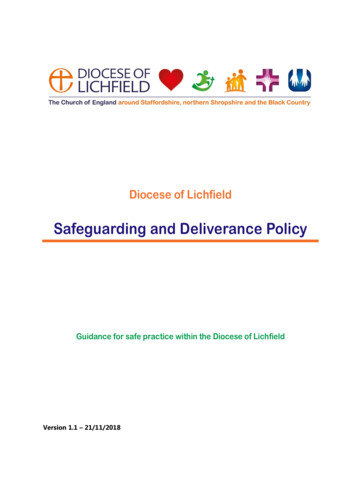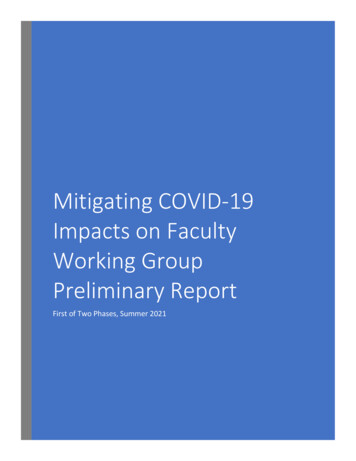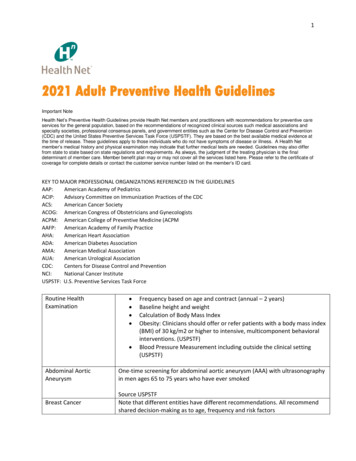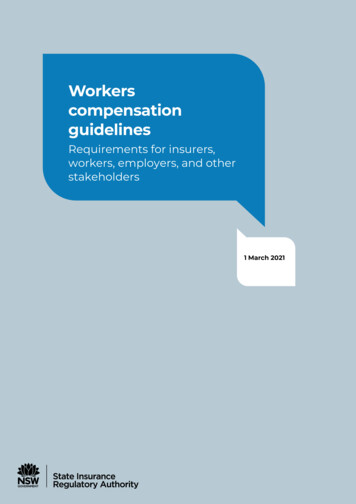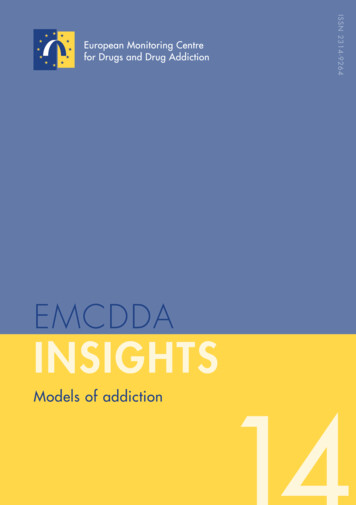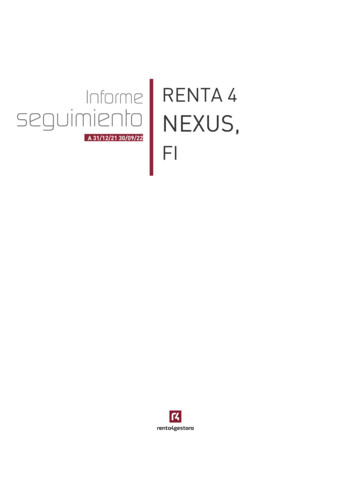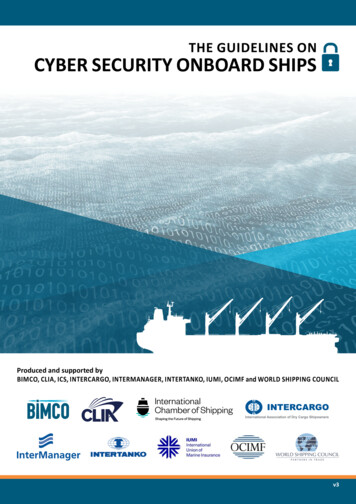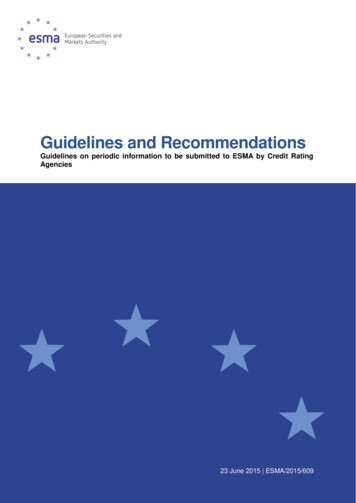
Transcription
Guidelines and RecommendationsGuidelines on periodic information to be submitted to ESMA by Credit RatingAgencies23 June 2015 ESMA/2015/609
Table of Contents1Scope. 32Definitions . 33Purpose of Guidelines. 34Compliance and reporting obligations . 35Information to be contained in the periodic submissions . 35.1Financial revenues and costs (per type of credit rating and on individual andconsolidated basis) . 45.2Staff turnover, vacancies and key promotions . 45.3FTE headcount. 55.4Internal complaints submitted to the Compliance Department . 55.5Board minutes, independent non-executive directors’ opinions and reportssubmitted to the Board . 55.6Court, arbitration and other dispute resolution proceedings . 55.7Potential and actual cases of non-compliance with the CRA Regulation that havebeen identified and measures taken . 665.8Organisational charts . 65.9Compliance, Internal Audit, Risk Management . 65.10Enterprise IT strategy . 75.11Other areas . 75.12Notifications of material changes to the initial conditions for registration . 75.13CRA supervisory fee and market share calculations. 85.14CRA market share calculation . 9Annex 1: Summary of periodic information to be submitted to ESMA by Credit Rating Agencies . 111
Acronyms usedCRA RegulationRegulation (EC) No 1060/2009 of the European Parliament andof the Council (as last amended by Regulation (EU) No462/2013).CRACredit Rating AgencyESMAEuropean Securities and Markets AuthorityHRHuman ResourcesIAInternal Audit2
1 ScopeWho?1. These Guidelines apply to credit rating agencies (CRAs) registered in the EU. Theseguidelines do not apply to certified CRAs.When?2. The guidelines will become effective two months after their publication on ESMA’s websitein all the official languages of the EU.2 Definitions3. ESMA Regulation: Regulation (EU) No 1095/2010 of the European Parliament and of theCouncil of 24 November 2010 establishing a European Supervisory Authority (EuropeanSecurities and Markets Authority), amending Decision No 716/2009/EC and repealingCommission Decision 2009/77/EC.3 Purpose of Guidelines4. The Guidelines set out the information that should be submitted by CRAs to enableESMA’s ongoing supervision of CRAs on a consistent basis. The Guidelines also clarifyESMA’s expectations of the information that should be submitted to ESMA for thecalculation of supervisory fees and CRAs market share.4 Compliance and reporting obligations5. This document contains guidelines issued under Article 16 of the ESMA Regulation. Inaccordance with Article 16(3) of the ESMA Regulation, financial market participants mustmake every effort to comply with the guidelines and recommendations.5 Information to be contained in the periodic submissions6. This Section sets out the information that CRAs should submit to ESMA on a quarterly,semi-annual and annual basis as part of their periodic submissions. Information should besubmitted within one month following the end of the quarter concerned.3
PeriodSubmission deadline1Q 20xx (up to 31 March 20xx)30 April 20xx2Q 20xx (up to 30 June 20xx)31 July 20xx3Q 20xx (up to 30 September 20xx)31 October 20xx4Q 20xx (up to 31 December 20xx)31 January 20x(x 1)7. Please note that, where potential infringements of the CRA Regulation that pose a risk tothe integrity and objectivity of existing credit ratings have been identified (includingpossible fraudulent or irregular activity (e.g. employee or manager misconduct)), CRAswill wish to consider informing ESMA of them promptly. CRAs will be aware that a failureto do so would, in the event of an infringement being found, prevent the firm from relyingon the mitigating factor set out in Point 3 of Section II of Annex IV of the CRA Regulation(“If the credit rating agency has brought quickly, effectively and completely theinfringement to ESMA’s attention, a coefficient of 0,4 shall apply.”).8. ESMA does not intend that a CRA will waive legal privilege in submitting the periodicinformation included in these guidelines.A. Quarterly information submissions5.1 Financial revenues and costs (per type of credit rating and onindividual and consolidated basis)9. ESMA should receive information on quarterly revenues per i) type of credit rating and ii)costs.10. Quarterly revenues should be split across the following types of credit ratings: CorporateNon Financials; Corporate Financials; Sovereign/Public Finance; Structured Finance;Covered Bonds.11. Quarterly costs should show operational and total costs on a separate basis. Operationalcosts should be an approximation of earnings before interest and tax charges. Figuresshould be presented as quarter-on-quarter revenues and costs (rather than year-on-year).12. CRAs exempt from an annual supervisory fee should submit this information semiannually, rather than quarterly.5.2 Staff turnover, vacancies and key promotions13. Quarterly turnover of Senior Management (including senior IT management), LeadAnalysts and Analysts should be provided. CRAs exempt from an annual supervisory feeshould submit this information semi-annually, rather than quarterly.4
5.3 FTE headcount14. In addition to staff turnover data, ESMA should receive a quarterly report of the totalnumber of staff working at a CRA expressed in terms of Full Time Employees. CRAsexempt from the annual supervisory fee should provide this information semi-annually,rather than quarterly.5.4 Internal complaints submitted to the Compliance Department15. CRAs should submit to ESMA on receipt of a complaint within the scope of theRegulation:oooA description of the content of the complaint;The follow-up actions undertaken by the CRA;Information on whether an internal investigation was opened as aconsequence, including whether the investigation is ongoing or closed at thedate of reporting; where the investigation has been closed, a copy of anyconsequent report made in respect of the investigation.B. Semi-annual information submissions5.5 Board minutes, independent non-executive directors’ opinionsand reports submitted to the Board16. CRAs should submit on a semi-annual basis:o The minutes of their board meetings;o A copy of documents sent to management and supervisory board members inadvance of their respective board meetings, as well as additional documentsdiscussed in the meeting (for instance, reports made by Compliance, InternalAudit Risk, internal review reports function, information security and riskfunction);o Where an independent non-executive director’s (INED) opinion is provided ina standalone document, CRAs should submit in the semi-annual submissionany opinions presented by a CRA’s INED(s) pursuant to point 2 of Section Aof Annex I of CRA Regulation and all reports (including follow-up reports)issued by an independent director.5.6 Court, arbitration and other dispute resolution proceedings17. ESMA should receive semi-annually a brief description of, and updated information onpending and current court proceedings, arbitration proceedings and any form of bindingdispute resolution proceedings which are/were in being at any point in time during thereporting period, and which may adversely impact the continuity or quality of ratingsand/or materially impact the financial position of a CRA. This description should include a5
summary of the proceedings and of the potential outcome of the proceedings in terms ofliability.5.7 Potential and actual cases of non-compliance with the CRARegulation that have been identified and measures taken18. CRAs should provide semi-annually detailed information regarding possible cases thatmay result in non-compliance with any of the initial conditions for registration, including:a. A description of each case which may result in a possible non-compliance withthe initial conditions for registration;b. A statement of the reasons why such case has arisen;c. A statement of the actions undertaken by the CRA following the identification ofthe case concerned;d. A statement of whether an internal investigation has been opened in relation tothe case concerned and of whether such investigation is ongoing or closed;and where closed, furnish a copy of any consequent report made in respect ofthe investigation.5.8 Organisational charts19. CRAs should submit semi-annually organisational charts if there have been updates tothe organisational charts. Such organisational chart should provide such detail as willenable ESMA to identify the structure of the following departments and should describethe main functions of the departments:oooooooCompliance function;Internal Audit;Internal Review function;Business lines in charge of the ratings activities;Information Security function;IT department;Risk function.5.9 Compliance, Internal Audit, Risk Management20. Each CRA should submit semi-annually its Compliance work plan in any case where anupdated version of such plan has been produced during the period.21. Where a CRA has established an Internal Audit function or commissioned internal auditsfrom an external party, ESMA should receive a copy of the Internal Audit updated workplan in any case where an updated version of such plan has been produced during theperiod.22. Each CRA should submit to ESMA copies of the reports issued by its compliance,internal audit, and risk management (covering, for example, operational or informationsecurity risks). CRAs should provide details of any follow-up action identified to mitigate6
those risks.5.10 Enterprise IT strategy23. ESMA should be informed semi-annually of CRAs’ enterprise IT strategies and of anychanges made thereto.24. ESMA should be informed semi-annually of CRAs’ IT work plans and of any changesthereto. CRAs should also provide updates on the implementation status of the work plan.5.11 Other areas25. CRAs should also report semi-annually: New potential and actual conflicts of interest identified and measures taken inresponse thereto; Information on any internal review being initiated or intended to be performedon rating models and rating processes; Outcomes of the methodology reviews including information on any backtesting performed in the period, details of any key findings as well as actionstaken by the CRA as a result.5.12 Notifications of material changes to the initial conditions forregistration26. ESMA considers a “material change” to be a change in the information submitted inthe registration application and, more generally, any change that may affectcompliance with the requirements of the CRA Regulation.27. A CRA should notify ESMA of any material changes to the conditions of its initialregistration, including but not limited to the following matters:a. Opening and closing of branches;b. Use of endorsement;c. CRAs’ right to an exemption(s) given at registration;d. Outsourcing arrangements;e. Legal form;7
f.Business structure (including reorganisation or restructuring of the CRAactivities and spin-offs);g. Type of business activities (including the provision of a new service andlaunch of new product in either the rating or non-rating business);h. Class and/or type of credit ratings;i.Ownership structure: acquisition or disposal of holdings above 5% of capital;j.Membership of the supervisory/administrative board;k. Compliance function and review function;l.Procedures used to issue and review credit ratings;m. Financial resources (including change share capital or long term debt);n. Rating methodologies, models or key rating assumptions;o. IT process and information processing systems supporting the rating process,such as changes in IT governance.5.13 CRA supervisory fee and market share calculationsSupervisory fee28. For the purpose of calculating the supervisory fees, CRAs should submit to ESMAtheir annual audited accounts for the previous year, at the latest by 31st May eachyear.29. The basis for the calculation of the supervisory fee is the revenue generated from theCRA’s credit rating activities and ancillary services. A CRA providing a service orservices other than credit ratings should provide ESMA with a detailed description ofsuch service(s) so that ESMA can assess whether the service(s) concernedconstitute non-rating services, non-ancillary services or ancillary services.30. Where a CRA, with annual total revenue of at least 10 million euro, identifiesrevenues as generated from non-rating activities and/or non-ancillary services, theCRA should provide ESMA with a detailed description of such activities and services.This is to allow ESMA to assess whether the revenues generated from those activitiesand services are eligible for deduction from the applicable turnover. The amountscorresponding to those non-rating activities and non-ancillary services should beappropriately certified by the CRA’s external auditors1.1Certification may be done by the CRAs external auditor through different means such as a specified procedures report or anagreed-upon procedure report with the CRA’s external auditor, a statement of the CRA’s revenues or amounts billed by theCRA’s external auditor, or by including this certification request in the audit engagement with the CRA’s external auditor.8
31. Where a CRA with annual total revenue of at least 10 million euro provides creditrating activities and ancillary services to different clients, it may request to deduct therelated revenues from the calculation of the revenues generated from ancillaryservices. The CRA should provide ESMA with a detailed description of its internalstructure, as well as relevant policies, processes and procedures, if any. This is toenable ESMA to assess, on a case by case basis, whether the outcome is theprovision of services to different clients thereby removing potential conflict of interestand the need for supervisory scrutiny. On this basis, ESMA will determine whetherthe revenues generated from the differentiated client bases are eligible for deductionfrom the applicable turnover. The amounts corresponding to the revenues generatedfrom ancillary services which are provided to different clients who do not receiverating services in the applicable financial year should be appropriately certified by theCRA’s external auditors on a client-by-client basis and aggregated basis. Any changeto the CRA’s structure or to the relevant policies, processes or procedures relative tothe provision of ancillary services to a given client should be communicated to ESMAwithout undue delay.32. For the purpose of the above-mentioned calculation and the assessment of theabsence of potential conflict of interests, ‘client’ means any client within the meaningof the term as defined in the last paragraph of point 2 of Part II of Section E of AnnexI of CRA Regulation who does not receive any rating service from the CRA group2.33. Where a CRA requests any other adjustment to the applicable turnover (such as theelimination of intercompany transactions), the CRA should provide ESMA with adetailed description of the requested adjustment and the reasons for such anadjustment. The amount corresponding to such adjustment should be appropriatelycertified by the CRA’s external auditor.34. The calculation of a CRA’s supervisory fees is without prejudice to ESMA’s ongoingsupervisory powers to assess whether the provision of ancillary services provided bya CRA constitutes a potential conflict of interest and, where this is the case, to adoptappropriate measures in accordance with the CRA Regulation.5.14 CRA market share calculation35. As the calculation of CRA’s market share is made on the same basis as thecalculation of supervisory fees, the guidelines for calculating the applicable turnoverfor supervisory fees will be applicable to the calculation of the CRA’s market share.36. For the purpose of calculating the yearly CRA’s market share, CRAs with a financialyear other than the calendar year should provide ESMA with the financial accounts2The final paragraph of point 2 of Part II of Section E of Annex I of the CRA Regulation states: “client means an entity, itssubsidiaries, and associated entities in which the entity has holdings of more than 20%, as well as any other entities in respectof which it has negotiated the structuring of a debt issue on behalf of a client and where a fee was paid, directly or indirectly, tothe credit ratings agency for the rating of that debt issue.”9
adjusted to the calendar year. The amounts corresponding to such adjustmentsshould be appropriately certified by the CRA’s external auditors. A CRA may alsoprovide audited financial statements broken down by quarter or by other time periodsas long as the information enables ESMA to make its annual calculation for the totalmarket share and the calculation of the supervisory fees.10
6 Annex 1: Summary of periodic information to besubmitted to ESMA by Credit Rating AgenciesA. Quarterly information submissions Financial revenues (per type of credit rating and on individual and consolidated basis)and costs (semi-annually for CRAs exempt from supervisory fees); Staff turnover, vacancies and key promotions (semi-annually for CRAs exempt fromsupervisory fees); FTE headcount (semi-annually for CRAs exempt from supervisory fees); Internal complaints submitted to the Compliance Department.B. Semi-annual information submissions Information on the initiation of any internal review being performed or intended to beperformed on rating models and rating processes; Outcomes of methodology reviews including information on any back-testingperformed in the period, details of any key findings as well as actions taken by theCRA as a result; Compliance, Internal Audit, Risk Management and IT strategy and governance; Potential cases of non-compliance with the CRA Regulation that have been identifiedand measures taken; New potential and actual conflicts of interest identified and measures taken; Board minutes, INED opinions and reports submitted to the Board; Court, arbitration and other dispute resolution proceedings; Updated organisational charts.11
on the mitigating factor set out in Point 3 of Section II of Annex IV of the CRA Regulation ("If the credit rating agency has brought quickly, effectively and completely the infringement to ESMA's attention, a coefficient of 0,4 shall apply."). 8. ESMA does not intend that a CRA will waive legal privilege in submitting the periodic
